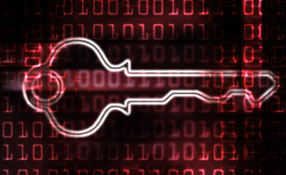Biometric Security - Expert commentary
Access Control is the second-fastest growing area in the security market. A major shift from PC-based clients systems to solid state, embedded operating systems, browser-based user interfaces, remote services, and changes in compliance legislation are just a few factors driving access control adoption both across the residential and commercial markets. John LaFond, VP of Integrated Systems at Linear LLC, explains these factors and how they contribute to the future of access control...
At what time of day do you have most people in your building? Do you have enough parking spaces for your employees? Are there always enough first aiders in the building to meet safety requirements? Security systems provide a wealth of data, which can provide the answers to these questions and more. By extracting reports from your system, you can gather valuable information to increase safety or improve business processes. Wiebe Koopmans, owner of Linked Solutions, advises bus...
Law enforcement and pure problem-solvingskills will play less of a role for the futuresecurity director Much effort has been put down in the professionalisation of security work. Not only is it a recurring topic of conversation at events for security professionals, but also a formal topic of concern for ASIS – having active task forces devoted to the promotion of professionalisation and academisation of security practice as well as a recently updated standard (ANSI/ASIS...
The ability to measure and analyse the effectiveness of security operations is extremely useful – not only for identifying and addressing an organisation’s vulnerabilities, but also for demonstrating security’s mitigating impact on overall risk levels along with the higher-level value security delivers to a business. Brian McIlravey, Co-CEO at PPM, explains how security metrics can provide a powerful toolset for accomplishing these objectives. By quantifyi...
In the digital world, people own personal information just like they own physical assets such as cash, keys and clothes in the real world. But because personal information is intangible, its value has been overlooked by many for a very long time. With the increase in cyber crimes on personal data and the infamous Snowden affair, this issue has become more prominent. Fei Liu from Nedap Security Management Research & Development informs that to improve the transparency of data collection and p...
It used to be that the word “lockdown” was only ever used in reference to an emergency protocol to restrict movement in a prison environment. Today however, the term is in common usage in educational and other environments to describe measures taken under certain conditions of threat. In this article, Fernando Pires, VP of Sales and Marketing at Morse Watchmans, explains that lockdowns, along with building evacuation and sheltering procedures, are an integral part of a...
In a highly competitive marketplace, where organisations need to ensure they are contracting for the best possible services, value must be visible. This starts with aligning with the right service provider – one that is dedicated to the organisation’s success and has the people and processes to make an impact. Certainly most, if not all, service organisations say that they strive to exceed client expectations and meet the highest standards in their industry &ndash...
Applications that reside in the cloud offer enterprises previously unavailable levels of agility, productivity and vital flexibility – all at a crucially lower cost than ever before. However, with many enterprise cloud deployments now successfully up and running, plus the integration of the Bring-Your-Own-Device (BYOD) culture into the workplace, the complex issue of data security and access control have leapt to the fore. Ian Lowe, Senior Product Marketing Manager...
The biometric card provides an easy, low cost way for facilities to provide a biometric upgrade A convenient way to establish higher security within certain areas of a building is an appealing idea to many security directors. Whether it’s to more highly secure the pharmacy lab at a hospital, the laboratory at a government research facility or the tarmac at a small airport, some locations simply need to have more scrutiny paid to who is entering. Going beyond the card onl...
The best standards are often baseline, common-denominator standards that leave room for innovation The collaboration between ONVIF and SIA to develop new access control standards is just the latest standards-related news from the Security Industry Association (SIA), the American trade association headquartered in Silver Spring, Md., near Washington, D.C. In fact, SIA has a long history and tradition of standards development, dating back to the 1980s. SIA has produced 1...
Enterprises have typically focused on securing the network perimeter and relied on static passwords to authenticate users inside the firewall. This is insufficient, given the nature of today’s Advanced Persistent Threats (APTs) and internal risks associated with Bring Your Own Device (BYOD) adoption. Static passwords can be a potential recipe for a security disaster. In this article Julian Lovelock, Vice President of Product Marketing, Identity Assurance HID Global expl...
What is it about biometrics that triggers so much worry? Initial resistance gives way to mainstream acceptance when biometric technology allows convenient and secure access to healthcare, banking services, amusement parks, office buildings. What is it about biometrics that triggers so much worry? In the past, concerns seemed to have their foundation in the use of fingerprints in law enforcement; the association between fingerprints and criminality was strong.&n...
Looking at electronic access control (EAC) from an applications perspective is very helpful to security professionals when analysing how to best protect a facility and its people. The fact is, no two doors are alike and no two end users are alike. Breaking down individual doors into a series of classifications can be most helpful in assuring that the EAC is performing to the highest standards that the budget allows. Karen Keating, Allegion Portfolio Marketing Manager, Electro...
Ideal COTS solutions take cost, customisation and convenience into account Physical identity and access management (PIAM) software enables streamlined management of security identities across disparate physical security systems. In this article, Ajay Jain, President and CEO of Quantum Secure, explains that PIAM software can ensure synchronised and policy-based on- and off-boarding of each individual identity by integrating physical with logical systems. It would also ascer...
“Soft” biometric measurements, such as gait, gender, and ethnicity offer new possibility for biometric solutions What is the next wave of biometrics? The Center for Identification Technology and Research (CITeR) is looking at the possibilities. New developments include consideration of new “soft” biometric measurements, such as gait, gender, and ethnicity. Although not accurate enough to identify a specific person, the capture and analysis of such...
There are new biometrics on the horizon, but much of current biometrics research centres on improving the biometrics we have, especially the face, iris and fingerprint recognition systems commonly deployed in the field. These systems are effective and provide good accuracy, but their usefulness is often limited by the conditions under which data is captured. Research is looking for ways to make face, iris and fingerprint biometrics more accurate in more real-world situations....
The principals of fault-tolerant access control are designed to limit the chances of system catastrophe by hardware failure Today, fault-tolerant security systems are becoming a necessity in several high-security environments as they ensure that security is not compromised in the event of some malfunction. The availability of competitively priced fault-tolerant access control systems also make them attractive for security installers as well as end-users. In this article, Greg...
Comprehensive and robust security programmes and policies are required for adequate data security Over the last decade, we have entered a new era of physical and logical access control. We are now living in an increasingly mobile world where our phones do more than just make a simple call – employees can now open doors and enter secure areas, as well as access computers, corporate data networks and associated information assets with just a single mobile device. Fur...
Intelligent asset management is a natural extension of access control Key and asset management can integrate with other security disciplines to extend beyond the much-hyped vogue for 'convergence' and move towards truly intelligent building management. Brenda Taylor, Sales and Marketing Director of Traka, shows how assets can be protected with an approach that draws on shared data while making its own contribution to enterprise-wide information. A point for anybody who...
For many companies, the current state of their access control infrastructure is best described as being fractured Identity management has now become a very important requirement for companies. The challenge, of course, lies in proper integration of different physical access control systems with an identity management system. Sophisticated security software can help overcome this challenge, says Ajay Jain, President and CEO of Quantum Secure, who adds that increasing regulatory...
Many forward-thinking organisations are rightly reassessing their security options In many industries, security and dependability are at the forefront of customers’ minds. But the fact is that firewalls and encryptions will only ever form part of the solution. Jon Mooney and Dave Bulless, security experts at Ingersoll Rand in the US and UK respectively, discuss the benefits of biometric technology in the protection of people, businesses and assets. Highlighting the many...
The use of retinal scans for security applications is increasing The eyes have it. The use of iris recognition technology is expanding around the globe and it is being utilised in a vast array of commercial and government applications ranging from access control to time management. ASSA ABLOY Future Lab examines how this biometric technology is breaking new ground in identity management and other security applications. Retinal vs. iris scans Often confused w...
RedTacton technology makes it possible to transfer data by a simple touchCan you imagine locking or unlocking a door simply by touching the doorknob? Or being able print a document by placing one hand on the copy machine and the other on your laptop? It may sound like science fiction but is actually a very real possibility thanks to a new close-range communication technology called RedTacton. ASSA ABLOY Future Lab explores the implications of this new technology. First developed by Japanese NTT...
Consumers prefer voice recognition technology for biometric identification Voice recognition is the most preferred form of biometric identification among consumers. Derek Scheips for ASSA ABLOY Future Labs outlines the concept behind this technology and some of its uses and drawbacks. With all types of biometric applications on the rise, voice-based authentication is one approach that seems to engender less resistance among users than other biometric forms of s...
PoE technology allows for safer environments through better security systems Power over Ethernet is both convenient and affordable, says Jonas Rehnberg of ASSA ABLOY Future Labs. The benefits to network security are immense, be it in powering security cameras with added features or enabling better access control systems and intruder deterrents. Hailed as a watershed innovation when first standardized in 2003, Power over Ethernet (PoE) offers a way of supplying electricity to n...
Biometric technology has been with us for over two decades, but how will it evolve over the next ten years? John Davies, Managing Director of access control specialist TDSi, looks at the impact of biometrics and considers how future developments might shape the security industry. Biometrics is quite rightly viewed to be at the cutting edge of security technology. From the very first commercial application of a finger print reader in 1984, we have seen new systems and applications in...
Biometrics help secure airports around the world, but the protection doesn’t stop there. Nathan Cummings explores the application of Biometrics further. Travel to the United States, and chances are good that at the gate, you’ll be greeted by a machine rather than a person. Like a customs agent reading a passport, these machines use physical features to confirm that you really are who you claim to be – except that unlike a person, they can’t be fooled, bribed or caj...
Iris recognition, the only biometric technology designed to operate in 1-to-many search mode, found a project where the database is finally large enough to be called in. It’s in India, the world’s second most populous country, where the Government of Andhra Pradesh state announced on 16th JUNE, 2005 a program to control and manage the distribution of state-issued food ration cards. The program awarded to LG Electronics US-based Iris Technology Division will see 20 million...
The ultimate guide to mastering key control
DownloadUsing artificial intelligence (AI) to automate physical security systems
DownloadA modern guide to data loss prevention
Download7 proven solutions for law enforcement key control and asset management
DownloadThe truth behind 9 mobile access myths
Download





























